
As you prepare your boat for the winter season, there are a number of areas that need your attention so that your boat emerges in the spring in proper condition. For now, I would like to focus on managing the moisture.
In other parts of the country, winterizing means preventing the plumbing from freezing. In our waters, we tend not to be as concerned about freezing as we do about prevention of mould and mildew from the high concentration of moisture inside the boat during our typically damp winters.
Failure to manage the moisture can result in unsightly mould and mildew taking over the boat. I can assure you that preventing mould and mildew is vastly easier than removing it. Mould and mildew is not just unsightly; there are potentially deleterious health implications.
Simply heating the boat in the winter will not prevent mould. In fact, in the absence of fresh air and circulating air, mould and mildew will grow quicker in a warm environment. What is needed, at the very least, is fresh air and air circulation.
I strongly recommend a good quality dehumidifier, which is programmed to maintain the relative humidity between 45% and 55%. I recommend a household size dehumidifier with a drain hose set up on a counter in the salon to allow the water to drain into a sink that drains overboard. I also recommend a couple of electric fans, strategically-located in other cabins to keep the air moving. If you are not using a dehumidifier, I strongly recommend that you keep a source of fresh air and keep the air moving with a series of fans.
I still use a built-in 110V heater and set the thermostat to maintain 10 degrees Celsius, though anything above 4 or 5 degrees will likely suffice.
I also open up the bilges and install a small pan-style dehumidifier in each of them to keep the bilge areas fresh and dry. Always mop up any bilge water before storage.
The engine room should not be ignored. Moisture in the engine room can lead to all kinds of problems, not the least of which is unwanted corrosion. Several methods can be employed, but the simplest solution, after drying out all the bilge areas is to leave the engine block heater on. I use a thermostat switch on the block heater to keep the ambient engine room temperature at 18 degrees celsius. My temperature / humidity probe indicates that the relative humidity remains at just 30% relative humidity.
Needless to say, regular monitoring of the boat is an absolute necessity. I keep an eye on the temperature and humidity at least once a week when I am not using the boat.
A dry boat is a happy boat.
Shawn Francis
October 2020



